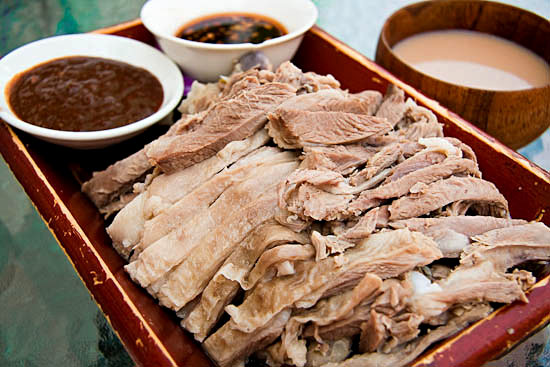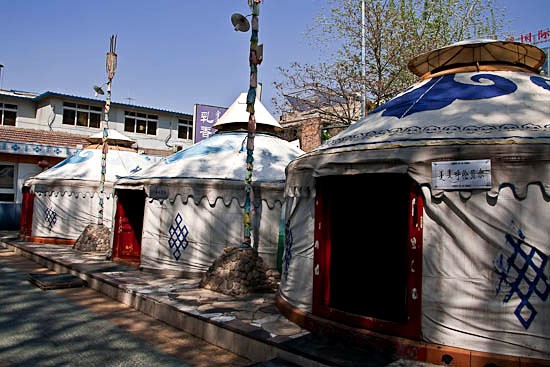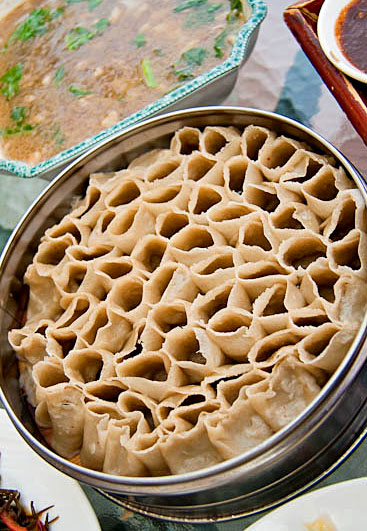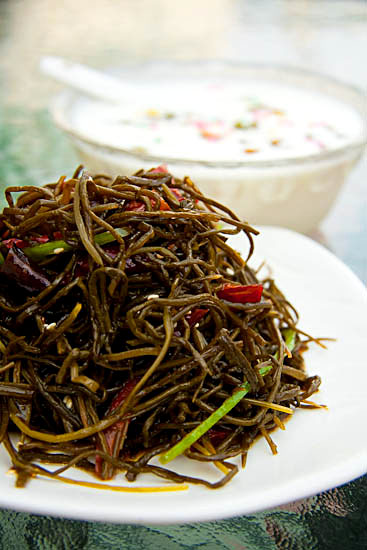Ordos, in central Inner Mongolia, is perhaps one of the more surreal places in China one could visit. It’s known for, among other things, vast coal reserves and mines, the mausoleum of Genghis Khan, a new, expensive, and completely uninhabited ghost city, a renewable energy park totalling some 11,900 megawatts of power, and a contemporary art & architecture complex funded by a dairy king. And it’s all in the desert, in the middle of nowhere. That’s the power of Chinese officialdom for you: anything can be built, anywhere, to prove the power [and corruption] of middling official Z.
In its own way, the restaurant run by the Ordos government’s representative office in Beijing is no less surreal, tucked inside a 1980s-style apartment complex. After walking through the derelict corridors of the Ordos guesthouse, we found ourselves in a cluttered courtyard, lined with not one but eight yurts.
Named after various famous grasslands, the yurts are dim, musty, and somewhat grungy. We were pleased; this was exactly the way it had been in Inner Mongolia: authenticity was assured. Nonetheless, we chose to sit outside.
The servers wiped off a set of metal and glass garden table and chairs, which might not have looked out of place in a real garden. But here we were, with yurts on one side and a dilapidated hotel on the other, in the shadow of the cement apartment blocks of Qingnianhu.
After some vacillation over the long but largely mutton-themed menu, we settled on shouba rou as a reasonably sized main dish for two. Barbecued and grilled cuts of ribs, legs, and even whole sheep (RMB 68 and up) would have been tempting, had we been a larger and more carnivorous party, but shouba rou (手把肉, RMB 30 per 500g) is a sure test of the freshness and quality of the restaurant’s mutton.

Boiled in water with just a little salt, the resulting meat is so tender that it almost falls off the bone. When last I encountered this in the Alxa League of Inner Mongolia, it was more delicious than I ever thought boiled mutton could be – it sounds bland, doesn’t it? But the sheep in Alxa League have it good, or so they say, roaming and grazing on the grasslands. Here in Beijing it obviously wasn’t quite the same, but still very impressive, with high-quality, lean cuts of meat. We ate it with our hands, as you are supposed to: this is hearty, grassland food, the simple fare of herders and nomads.
Dairy also features strongly here – did I mention that the name of this restaurant is “Milky Fragrance Floating” (乳香飘飘 Ruxiang Piao Piao)? Indeed. Mongolian-style cheese, curds, and milk tea are all on the menu, including a pot of salty milk tea (chaguo 茶锅, RMB 58) served with puffed rice and wind-dried beef. There was also yogurt (RMB 10), which I hoped might be homemade, but it disappointingly tasted just like commercial Yili yogurt topped with raisins and sprinkles. Sprinkles.
This is a youmian wo (莜面窝, RMB 16), a distinctive buckwheat noodle dish better known as Shanxi province’s famous youmian kaokao (莜面栲栲). It seems rather typical for different segments of Inner Mongolia (a long, extended region) to adopt dishes from the cuisine of their neighboring southern provinces – no doubt because they also attract more migrant workers from those areas. Hence, eastern IM has more Dongbei style cooking while western IM is more influenced by Gansu and Xinjiang. And perhaps coal barons everywhere are drawn to this dish due to its resemblance to a honeycomb briquette?
Youmian kaokao is made by rolling out lots of little squares of buckwheat dough, each of which are then formed into a ring and joined together with the others and steamed. You eat it by tearing off one ring at a time and dipping it in the accompanying broth or sauce, which in this case was a bland and greasy lamb and potato broth. Fortunately, the buckwheat noodles were tasty enough on their own, with a wonderfully chewy, al dente texture.
Better yet were the “desert scallions” (shacong 沙葱): I couldn’t get enough of this wild grass of the deserts in Inner Mongolia, and so was delighted to find it here. It resembles scallions in shape only; the flavor is fresh and crisp and sharp – exactly like what you might want to eat after spending an hour under the hot desert sun.
Here it was drizzled with a chili pepper oil dressing in the chiangban shacong salad (RMB 16, 炝拌沙葱). The desert scallions had been first dried and then reconstituted, but it was so like seeing an old friend that I hardly minded. After all, I had already been lucky enough to find a good Mongolian meal – no easy feat in Beijing.
3 Shanglong Beixiang, Andignmenwai Dajie (just outside the east gate of Qingnianhu Park, in the residential compound)
Dongcheng District
Tel: (010) 8412 4216
乳香飘飘 (鄂尔多斯宾馆内)
安定门外大街上龙北巷3号
(青年湖公园东门)







































[...] Yurts, coal barons, and mutton at the Ordos restaurant (Ruxiang … [...]
It definitely opens my eyes towards Mongolian cuisines. I’m particularly intrigued by the simplicity of the mutton preparation. When the ingredients are fresh, little work is required to create a wonderful dish.
looks like an interesting experience! and lol to sprinkles on yogurt!!
Where did you learn about this? Can you give me the source?
It’s some combination of personal experience in Inner Mongolia, articles I’ve read (The Guardian did some reporting about Ordos’s coal mining and clean energy aspirations), and random Googling. There are a few links in the article.